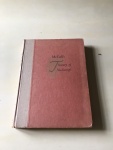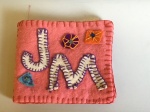One of the reasons I like to make my own clothes is that I can get a better fit for my body than I can buying a garment. Having said that achieving a good fit is proving very difficult. I’m lucky in that I’m average height and a fairly slim build and can usually find clothes that sort of fit me, but I want more than that I want a really good fit; one that is flattering and comfortable.
Being an inveterate book buyer I have bought three books on the subject and I thought it would be worth giving a quick review of them here.
The first book I bought was one that a lot of bloggers seem to mention; Fit for Real People by Palmer, Alto and Schilling. This book goes though the main alterations required for a pattern using a group of women with different fitting issues. It recommends using the tissue fitting system whereby you in the pattern tissue to the person you are fitting in order to detect fitting issues.
Personally I found this book too difficult. The tissue fitting system is not simple and can’t be done on yourself. I know it’s best to get someone to help you but my sewing buddy lives the other side of the country so I’m on my own most of the time. Having Dolly does make it easier but even so I don’t find pattern tissue as malleable as these ladies imply. Also patterns printed from the Internet or traced from Burda magazines are on stiff paper which just won’t bend around your body to give an idea of the fit.
The book covers a lot of fit issues but I found that it was too complicated to use practically. Every time I have tried to use it to make an alteration I have found myself putting it back on the shelf and referring to one of my other books or making it up as I go along. Having said that a lot of people seem to swear by this book and there are some fabulous reviews on Amazon so maybe I will find it useful once I am more experienced.
The second book I have is the Busy Women’s Fitting Book by Nancy Zieman. This was published in the 80’s and I bought it second hand along with the Busy Women’s Sewing Book, both books are fairly short but packed full of useful tips. The fit book is very straight forward and recommends using pivot and slide techniques. It’s very easy to make the adjustments recommended once you understand where you have fitting problems, but I didn’t find the “Prepare to Fit” chapter which outlines how to determine where to make adjustments helped me understand the issues I was having.
The third book is Fitting & Pattern Alteration by Leichty, Rasband and Pottberg-Steineckert. It was a horribly expensive book but has proved to be worth every penny. The book describes every fit issue and technique to fit known to man, describing each problem a bit like a medical text book; I find terms like “bones may be smaller than average/ideal, there may be less weight deposit and/or muscle development than average/ideal” rather off-putting as if the person is horribly deformed in some way. It then explains what fitting problems these issues will give and provides a number of options for altering ready made garments, toiles and pattern pieces. It is the only place I have found that explains the order you need to make alterations in. For my Tova dress I needed to lengthen and widen the shoulder and add more to the bust. This book was the only one that told me to adjust the shoulder length first before making any other adjustments. Having done this I could immediately see the other adjustments I required were much smaller than I had originally thought.
One thing that this book does is to show which measurements you need to make on yourself and your pattern pieces to indicate in advance where you might have fitting problems. All the books do this to a certain extent but this one is much more thorough. I haven’t tried using this yet but it looks like a useful feature and may reduce the number of toiles that have to be made.
I should also mention the Colette Sewing Handbook which has a chapter on fit. Given that this is only one chapter in the book it is surprisingly comprehensive and very useful for simple alterations. It didn’t help me with my long shoulder problem and the bust alteration described doesn’t go into details about how to adjust around an insert (like on the Tova dress) or how to adjust a princess seam. I also didn’t find it much help in adjusting my Beignet skirt pattern which had a much deeper curve between the waist and hip than my body has. Having said that if you have the fitting problems she describes I think this would be a really helpful book.
So what have I learned from all these books?
1) The standard method for analysing whether you need to adjust your bust doesn’t work for me. I have more or less the same upper bust measurement as my full bust but I am a D-cup and so will always need to add more into any pattern.
2) The order you make alterations in makes a difference and I need to alter my shoulder length before I consider any other fitting issues.
3) The fabric you use for a toile needs to be as close as possible to the final fabric you are intending to use. I’ve been using some rather stiff calico and have found that most of my final garments need to be considerably smaller. My first Tova dress was made out of a denim that has quite a lot of give. The second (which I am struggling with at present) is being made out of linen and needs to be larger around the bust and across the back.
4) There’s a certain amount of hit and miss with this stuff. Leaving a lot of seam allowance is important.
5) I have loads and loads to learn!
 Kate recently wrote a lovely post about Charity Shops which got me thinking about sewing books. But first I should start my a confession.
Kate recently wrote a lovely post about Charity Shops which got me thinking about sewing books. But first I should start my a confession. I come from a family of book addicts and I live with a book addict, so it’s quite a hopeless case. This is a picture of part of our library
I come from a family of book addicts and I live with a book addict, so it’s quite a hopeless case. This is a picture of part of our library

 ..and what about this one? McCall’s Treasury of Needlecraft from 1955 has chapters on embroidery, knitting, crochet, Glitter (who can’t resist “How to Use Sparkle in Decoration”?), Hair lace and Tatting, Home Beauty (about bedspreads and household linens rather than face creams) and Gifts. I love this Norwegian cardigan.
..and what about this one? McCall’s Treasury of Needlecraft from 1955 has chapters on embroidery, knitting, crochet, Glitter (who can’t resist “How to Use Sparkle in Decoration”?), Hair lace and Tatting, Home Beauty (about bedspreads and household linens rather than face creams) and Gifts. I love this Norwegian cardigan. Not all my books come from McCalls, I have a couple of Nancy Zieman “Busy Woman’s” books from the 1980’s. This one is about sewing and I have another about fitting.
Not all my books come from McCalls, I have a couple of Nancy Zieman “Busy Woman’s” books from the 1980’s. This one is about sewing and I have another about fitting. love modern sewing books too, however I get frustrated that so many are very basic with a greater focus on pictures than proper instructions. I suspect this is because sewing and knitting are no longer considered basic life skills that everyone should know something about. Hugo’s Father learnt how to knit at prep school when he was around 6 or 7, that would have been in the 1930’s. I was given weekly sewing classes in the 1970’s and still use the needlecase I made when I was 8 or 9. I also sewed with Mother and my Grandmother taught me how to knit. I learnt how to crochet on the school bus after we’d got bored of French knitting (does anyone do this now that thread is wound on plastic reels rather than wooden ones?).
love modern sewing books too, however I get frustrated that so many are very basic with a greater focus on pictures than proper instructions. I suspect this is because sewing and knitting are no longer considered basic life skills that everyone should know something about. Hugo’s Father learnt how to knit at prep school when he was around 6 or 7, that would have been in the 1930’s. I was given weekly sewing classes in the 1970’s and still use the needlecase I made when I was 8 or 9. I also sewed with Mother and my Grandmother taught me how to knit. I learnt how to crochet on the school bus after we’d got bored of French knitting (does anyone do this now that thread is wound on plastic reels rather than wooden ones?).


 References to “
References to “